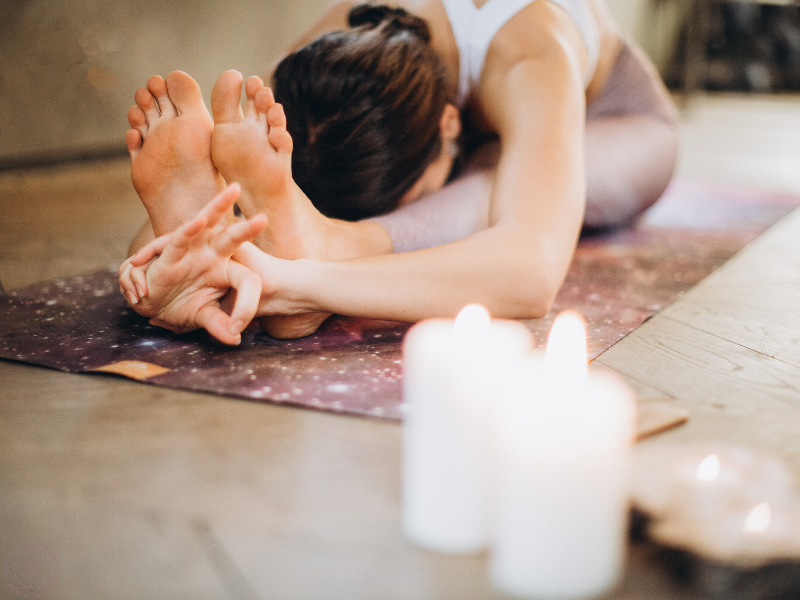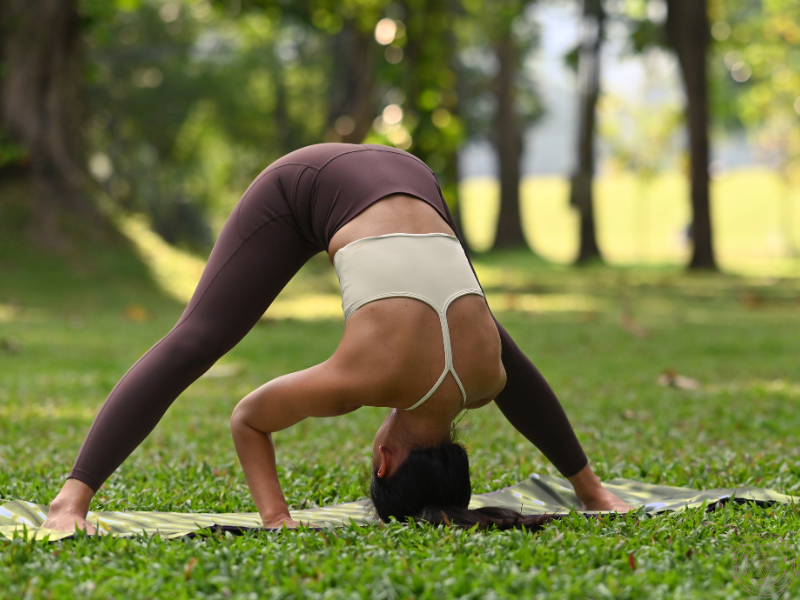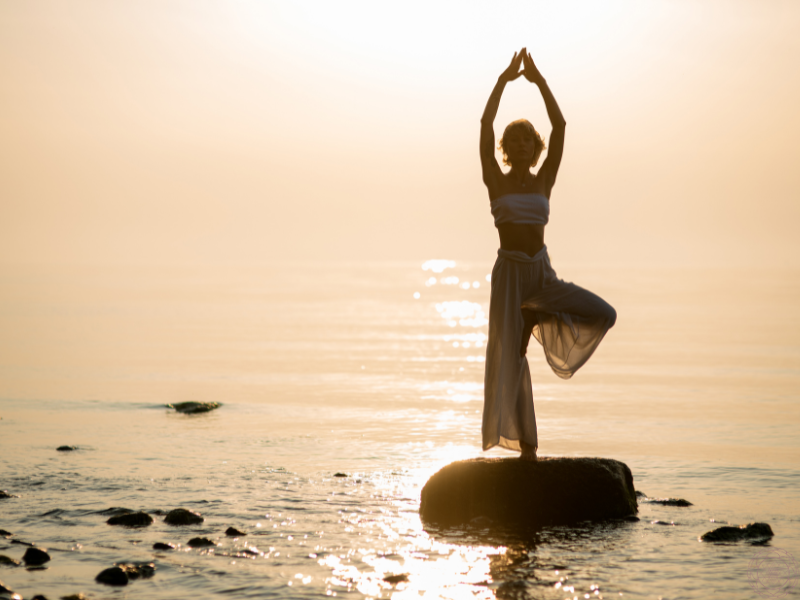Yoga is more than just a physical exercise; it’s a gateway to self-discovery, spiritual growth, and inner harmony. Among its many benefits, yoga asanas help activate and balance the body’s energy centers, known as chakras. This post explores 11 crown chakra yoga poses designed to enhance your spiritual awareness. These poses can awaken your connection to higher consciousness and help you find balance in a chaotic world.
What Are Chakras?
Chakras are energy centers located along the spine, each governing specific aspects of our physical, emotional, and spiritual well-being. Derived from the Sanskrit word meaning “wheel” or “disk,” chakras are seen as spinning vortexes of energy. There are seven main chakras, starting at the base of the spine and extending to the crown of the head. When these chakras are open and balanced, energy flows freely, leading to overall health and harmony.

What Is the Crown Chakra?
The crown chakra, or Sahasrara, is the seventh and final chakra. Located at the top of the head, it represents our connection to the universe, spiritual enlightenment, and higher states of consciousness. The crown chakra is associated with the color violet or white and is considered the bridge between individual and universal energy.
Signs of a Blocked Crown Chakra
- Feeling disconnected from yourself or others.
- Lack of purpose or spiritual curiosity.
- Experiencing frequent headaches or brain fog.
Indications of a Balanced Crown Chakra
- A deep sense of inner peace and contentment.
- Feeling spiritually aligned and connected.
- Clarity in thoughts and decision-making.
Signs of an Overactive Crown Chakra
- Difficulty grounding yourself in reality.
- Obsessive thoughts about spirituality or transcendence.
- Feeling detached from the physical world.
Benefits of Yoga Asanas for the Crown Chakra
Yoga asanas, or poses, help channel energy through the body while calming the mind. For the crown chakra, specific poses improve focus, stimulate the nervous system, and promote a sense of spiritual alignment. By incorporating crown chakra yoga poses into your practice, you can:
- Enhance mental clarity.
- Increase mindfulness and present-moment awareness.
- Deepen your connection to higher consciousness.

11 Expansive Crown Chakra Yoga Poses
1. Headstand (Sirsasana)
Benefits: Often referred to as the “king of asanas,” the headstand increases blood flow to the brain, stimulating the crown chakra. It also builds strength in the shoulders and core while improving focus and balance.
How to Perform:
- Begin in a kneeling position.
- Interlace your fingers and place your forearms on the mat.
- Rest the crown of your head on the mat between your hands.
- Slowly lift your legs off the ground, bringing them overhead. Balance carefully and hold.
Beginners may benefit from using a headstand bench.
2. Tree Pose (Vriksasana)
Benefits: This grounding pose strengthens balance while creating a connection between the earth and the sky. It aligns the body’s energy flow upward to the crown chakra.
How to Perform:
- Stand tall in Mountain Pose.
- Place one foot on the opposite thigh or calf (avoid the knee).
- Bring your hands to prayer position (Anjali Mudra) or overhead.
- Hold for several breaths, then switch sides.
3. Lotus Pose (Padmasana)
Benefits: A classic meditative posture, Lotus Pose cultivates stillness and supports the flow of energy to the crown chakra. It helps deepen your connection to universal consciousness.
How to Perform:
- Sit with legs extended forward.
- Cross one ankle over the opposite thigh and repeat with the other leg.
- Rest your hands on your knees, palms facing upward.
- Sit tall and breathe deeply.
4. Kapilasana (Kapila’s Pose)
Benefits: Kapilasana is an advanced seated forward bend that deeply opens the hips, stretches the spine, and enhances flexibility in the legs and shoulders. Named after the sage Kapila, this pose fosters concentration, inner strength, and physical resilience, making it a powerful posture for advanced practitioners seeking to stimulate the crown chakra.
How to Perform:
- Begin in Staff Pose (Dandasana), seated with your legs stretched straight out in front of you.
- Carefully lift one leg and bring it behind your head, allowing it to rest across your shoulders.
- Wrap your arms over the leg, clasping your hands together in front of your body.
- Fold forward gently from the waist, keeping the spine lengthened and avoiding strain.
- Hold the pose while maintaining deep, steady breaths.
This challenging asana is part of Ashtanga yoga’s fourth series, requiring strength, flexibility, and focus. Approach Kapilasana with patience, as it can take time to build the necessary skills to perform it safely and effectively.
5. Corpse Pose (Savasana)
Benefits: This restorative pose allows the body and mind to fully relax, making it an ideal posture for integrating crown chakra energy work.
How to Perform:
- Lie flat on your back with arms at your sides.
- Close your eyes and focus on your breath.
- Allow your body to release all tension.

6. Mountain Pose (Tadasana)
Benefits: Mountain Pose promotes alignment and mindfulness. It’s a simple yet powerful way to connect with the present moment and higher energies.
How to Perform:
- Stand with feet together and arms at your sides.
- Engage your thighs and lift your chest.
- Relax your shoulders and gaze forward..
7. The Great Lock (Maha Bandha)
Benefits: Maha Bandha represents the mastery of the body’s three vital energy locks- Jalandhara, Uddiyana, and Mula Bandha. This practice harmonizes and channels the flow of prana (life force), creating profound effects on both the physical and spiritual planes.
- Physical Benefits: Enhances vitality, supports the nervous system, and promotes overall energy balance.
- Spiritual Benefits: Facilitates heightened states of consciousness and profound self-awareness, serving as a bridge to inner transformation.
Ancient yogic texts describe Mahamudra Bandha as a path to unity with the universe, fostering a deep connection between body, mind, and spirit.
How to Practice:
- Initiate: Begin by sitting in a comfortable meditation posture. Padmasana (Lotus Pose) or Siddhasana (Accomplished Pose) are ideal.
- Align: Keep your spine straight, shoulders relaxed, and hands resting on your knees or in your lap. Close your eyes and take a few moments to calm your mind and body with steady, natural breaths.
- Engage:
- Take a deep inhalation, then exhale completely until your lungs are empty.
- Perform Jalandhara Bandha by tucking the chin toward the chest.
- Engage Uddiyana Bandha by drawing the abdominal muscles inward and upward.
- Activate Mula Bandha by contracting the pelvic floor.
- Maintain the breath outside (Bahya Kumbhaka) for as long as is comfortable, ensuring there is no strain. Beginners may start with a few seconds and gradually increase the duration over time.
- Release: To release the bandhas, follow this sequence:
- First, release Mula Bandha (pelvic floor).
- Next, release Uddiyana Bandha (abdominal lock).
- Finally, release Jalandhara Bandha (throat lock) and return the head to a neutral position. Inhale slowly and deeply.
- Integrate & Rest: This completes one round of Mahamudra Bandha. Rest between rounds by taking slow, relaxing breaths. Repeat the practice as many times as feels comfortable.
8. Rabbit Pose (Sasangasana)
Benefits: Rabbit Pose stretches the spine and stimulates the crown chakra, promoting introspection and surrender.
How to Perform:
- Kneel and lower your head to the mat.
- Hold your heels with your hands.
- Lift your hips slightly while keeping your head grounded.
9. Seated Forward Bend (Paschimottanasana)
Benefits: This pose calms the mind and relieves tension, preparing you for deeper meditation.
How to Perform:
- Sit with legs extended.
- Fold forward from your hips, reaching for your feet.
- Keep your back straight and breathe deeply.
10. Child’s Pose (Balasana)
Benefits: Child’s Pose is grounding and calming, creating a safe space for crown chakra meditation.
How to Perform:
- Kneel and sit back on your heels.
- Extend your arms forward and rest your forehead on the mat.
- Relax your entire body.
11. Wide-Legged Forward Bend (Prasarita Padottanasana)
Benefits: This pose increases blood flow to the head, enhancing focus and stimulating the crown chakra.
How to Perform:
- Stand with feet wide apart.
- Hinge at your hips and fold forward.
- Place your hands on the ground or hold your ankles.

Other Ways to Balance the Crown Chakra
Yoga isn’t the only way to support your crown chakra. Here are additional practices to try:
- Meditation: Visualize a violet or white light at the top of your head.
- Essential Oils: Use lavender or frankincense for spiritual clarity.
- Sound Therapy: Listen to chants or frequencies tuned to the crown chakra.
- Nature Connection: Spend time in quiet, open spaces like mountains or forests.
- Journaling: Reflect on your spiritual goals and experiences.
Cultivating a Deeper Connection Within
Crown chakra yoga poses offer a transformative path to inner peace and spiritual connection. By incorporating these poses into your practice, you can align your body and mind while deepening your connection to universal energy. Pair these poses with meditation and other balancing practices to experience lasting harmony.
This post was all about crown chakra yoga poses.
Other Posts You May Like:
Hi love!
I’m a Nutritional Therapy Practitioner and Dharmic Healer looking to guide you back to your true Self through various mind, body, and spirit healing modalities.
I’m Rana.
LEARN MORE
Leave a Reply Cancel reply
Rana is a Nutritional Therapy Practitioner and Dharmic Healer here to guide you back to your true Self through various mind, body, and spirit healing modalities.
HOME
ABOUT
CONTACT
BLOG
SHOP
OFFERINGS
© Mantras and Mulberries.